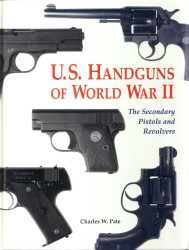CRUFFLER.COM
presents
Book
Review, June 2000:
| United
States Handguns of World War Two: The Secondary Pistols and Revolvers
by Charles Pate Andrew Mowbray Publishers, 1999, Hardcover, 368 pages ISBN 0-917218-75-2 |
 |
From its adoption in 1911 to its retirement in 1982, and to the present day, the United States pistol, caliber .45, Model 1911/1911A1, was an is a legend in its own time. These firearms hold positions of honor in collections and memories for crufflers, history buffs, and veterans alike. The "Colt 45" is one the most recognized and enduring sidearms ever fielded by any nation. This vision is only enhanced by Hollywood's depictions of U.S. forces at battle through the twentieth century.
However, during the Second World War, other handguns were also acquired and used by U.S. military organizations. In some situations, Colt and the other M1911A1 contractors simply could not keep up with demand, and in others cases a large frame, large bore pistol was not suited for the job at hand. Whether used in as a security guard's weapon, or far more glamorously in clandestine espionage operations, these handguns contributed greatly contributed to the war effort, despite standing in the M1911A1ís shadow.
Charles Pate has extensively researched these unsung heroes in his book, United States Handguns of World War Two: The Secondary Pistols and Revolvers. As a result, they may finally get some of the attention they so richly deserve. United States Handguns of World War Two: The Secondary Pistols and Revolvers chronicles the U.S. military's procurement of commercial pistols from the closing days of World War One through World War Two. Pate has done an tremendous amount of research, poring through military, government, and factory sources for archives and letters that tell the story of the various pistols acquired and used by U.S. and British military forces.
The book is divided into three main parts. Part One, "Background," covers the history and logistics of the acquisition of commercial handguns for the military. It then details the inspection system and enumerates and describes the various inspection, acceptance, and proof markings found stamped on individual firearms arms. The Chapter "Between the Wars" lists the various purchases of commercial handguns by the U.S. military from 1917 to 1942. The list is illustrated with period ads and the occasional photograph of the firearms in question. One portion of the book that may be of particular interest to crufflers is the Chapter dedicated solely to Model 1917 revolvers from Colt and Smith & Wesson from their origins to WWII use. The chapter entitled "Arming the Allies" discusses handguns sold to the British Commonwealth both before and after the Lend-Lease act of 1941 with tables that show the various markings used by the British government.
All of this leads into Part Two -- "U.S. Alternate Handguns of WWII." In this section, each chapter is dedicated to a particular manufacturer and family of handguns. This includes Smith & Wesson and Colt .38 caliber revolvers, Colt Pocket Automatic pistols, Colt .22 and .38 Super pistols, High Standard pistols, and Harrington & Richardson revolvers. These chapters tell the story about how these various arms were acquired and, to some extent, where they went. All of this information is well supported with archival documents and accompanied by many high quality photographs.
Pate is at his best when the chapters focus on individual models or families of handguns, and he does a superb job of combining a very well written text with period advertisements, reproductions of original letters and documents, photographs of the pistols, and official photographs of the handguns "in action". Each of these chapters has a page that lists all the characteristics and markings of the featured handgun so the average cruffler can use it as a guide to readily identify arms that may have seen service. Pate even lists where some of the examples were shipped to and who received them. Of particular note are the various pistols that were acquired for use by the Office of Strategic Services (the OSS, forerunner of today's Central Intelligence Agency).
Part Three is the catch-all, listing all the other handguns acquired in quantities too small to really merit individual chapters. Even so, Pate still finds documentation and period ads to emphasize they were just standard commercial production pistols rushed into military service. The Appendices list many interesting items that did not fit into any one chapter, such as markings found on ammunition and accessories, or documentation on modifications made to certain commercial pistols to make them more acceptable for military use.
Throughout the book, Pate has "Model Summaries" which provide extensive details about the arms in question, such as specifications, serial number ranges, and markings applied by various entities). Pate has also gone to great lengths to build up a collection of photographs of many of the handguns discussed, including ones comparatively rare markings. Furthermore, accompanying the chapters are photographs of the pistols as carried by servicemen that serve to give the book a historical context by placing it with the men and women who fought WWII. This context makes the book a must've for those who desire to learn about the historical nature of firearms.
But the book's true centerpiece has to be the documentation. From a variety of governmental and non-governmental sources, Pate has assembled an amazing array of correspondence, period advertisements, reproductions of the original factory manuals, factory letters, and actual invoices. All of this is woven in the fabric of each chapter.
United States Handguns of World War Two: The Secondary Pistols and Revolvers is a must have reference for anyone interested in looking beyond the .45 autos and big Webley revolvers to get the full measure of the handguns in US military service during World War Two.
United
States Handguns of World War Two: The Secondary Pistols and Revolvers
is
available from IDSA Books. Click on the image to order:
